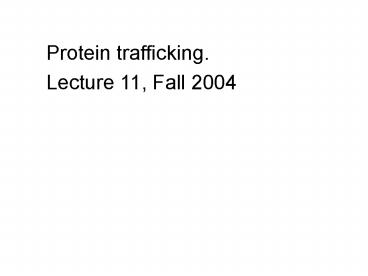Protein trafficking' - PowerPoint PPT Presentation
1 / 17
Title:
Protein trafficking'
Description:
In presynaptic cells, secretory vesicles (synaptic vesicles) containing ... are degraded in the lysosome arrive by endocytosis, phagocytosis, or autophagy. ... – PowerPoint PPT presentation
Number of Views:297
Avg rating:3.0/5.0
Title: Protein trafficking'
1
Protein trafficking. Lecture 11, Fall 2004
2
The Golgi Apparatus has two major functions 1.
Modifies the N-linked oligosaccharides and adds
O-linked oligosaccharides (O-link is to serine
or threonine). 2. Sorts proteins so that when
they exit the trans Golgi network, they are
delivered to the correct destination.
3
(No Transcript)
4
(No Transcript)
5
Secretion of the contents of a secretory vesicle
occurs in response to specific signals. In many
cases, binding of a ligand to a cell surface
receptor triggers secretion. In the nerve, the
action potential triggers secretion.
In presynaptic cells, secretory vesicles
(synaptic vesicles) containing neurotransmitters
are docked at the plasma membrane by SNAREs. The
arrival of an action potential causes
voltage-gated Ca channels to open and the
influx of Ca activates the SNAREs to fuse the
membranes. Neurotoxins that cause tetanus and
botulism incapacitate the fusion process by
entering the cell and selectively cleaving the
SNAREs.
6
Delivering lysosomal hydrolases to the lysosome.
7
The macromolecules that are degraded in the
lysosome arrive by endocytosis, phagocytosis, or
autophagy.
8
Lysosomes contain acid hydrolases that hydrolyze
a variety of macromolecules.
9
Newly synthesized proteins destined for the
lysosome are first transported to the late
endosome.
10
The acid hydrolases in the lysosome are sorted in
the TGN based on the chemical marker mannose
6-phosphate.
Hydrolases are transported to the late endosome
which later matures into a lysosome.
Adaptins bridge the M6P receptor to clathrin.
Acidic pH causes hydrolase to dissociate from the
receptor. M6P receptor is recycled back to the
TGN.
11
Mannose 6-phosphate tag.
The phosphate is added in the Golgi
This was first attached in the ER.
12
The creation of the M6P marker in the Golgi
relies on recognition of a signal patch in the
tertiary structure of the hydrolase.
Patients with a disease called inclusion-cell
disease have cells lacking hydrolases in their
lysosomes. Instead, the hydrolases are found in
the blood. These patients lack GlcNAc
phosphotransferase. Without the M6P-tag, the
acid hydrolases are transported to the plasma
membrane instead of the late endosome.
13
Endocytosis example of low density lipoprotein
and the LDL receptor.
14
Uptake of low-density lipoproteins (LDL) is one
of the best understood examples of
receptor-mediated endocytosis. LDL is a
protein-lipid complex that transports
cholesterol-fatty acid esters in the blood
stream. LDL normally supplies cholesterol to
cells. Defects in the endocytic process result
in high blood levels of LDL. High LDL
predisposes individuals for atherosclerosis.
15
Receptor mediated endocytosis is initiated at
clathrin-coated pits. Transmembrane receptors
bind ligands on the outside surface of the cell
and collect in coated pits via interactions with
adaptins and clathrin inside the cell. A single
coated pit can accumulate many different types of
receptors. The receptor-ligand complexes are
concentrated in a small area so become highly
concentrated in transport vesicles.
16
Normally, LDL binds the receptor and the
receptors collect in coated pits through
association with adaptins and clathrin.
Some individuals have defects in the cytoplasmic
domain recognized by adaptin so the receptors
never collect in the coated pits.
- Other genetic defects that result in elevated
blood levels of LDL - absence of LDL receptor.
- defective LDL-binding site in the LDL receptor.
17
In the case of LDL, LDL ultimately goes to the
lysosome and the LDL receptor is recycled back to
the PM.
pH 6 induces dissociation
Multivesicular body
Late endosome































